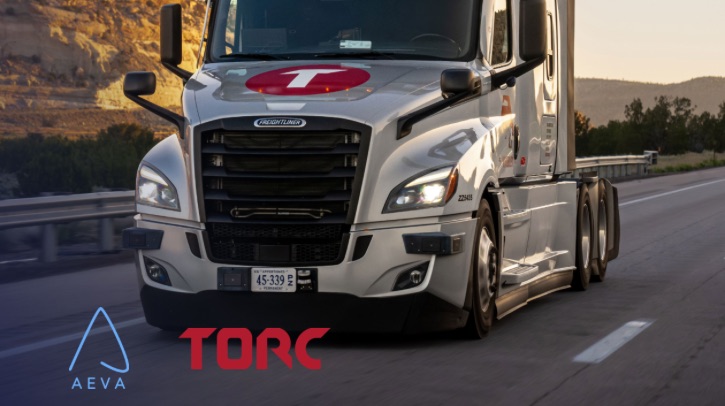Aeva, a supplier of sensing and perception systems, and Torc, an independent subsidiary of Daimler Truck specializing in self-driving technology, have announced an expansion of their collaboration to advance the development of a new safety architecture for truck applications.
Under the expanded collaboration, Torc and Aeva will work together on technology advancements in service of L4 autonomous trucking to benefit the development of Torc’s Virtual Driver vehicle software. The companies will share 4D lidar sensing data and share a Freightliner Cascadia vehicle platform for use in long-range sensing applications. The data captured will support deeper collaboration between global engineering teams at both companies.
“Aeva is pioneering the next generation of 4D lidar technology and we’re excited to enter a new phase of our collaboration to continue to position us as industry leaders in autonomous driving technology for production deployment at scale,” commented Peter Vaughan Schmidt, Torc CEO.
The collaboration builds on the production agreement signed last year when Daimler Truck selected Aeva as its supplier of long and ultra-long range lidar for its series production autonomous commercial vehicle program. The multi-year production agreement is targeting commercializing Daimler Truck autonomous trucks by 2027.
“Torc Robotics is a leader in commercializing autonomous truck technology and this expansion of our collaboration is a testament to the capabilities of our talented team and the strength of our production partnership with Torc and Daimler Truck,” said Soroush Salehian, co-founder and CEO at Aeva. “Now our global teams will work even closer together with joint sharing of sensing data from Aeva sensors on North America’s top trucking platform. We look forward to advancing our multi-year production collaboration to commercialize safe autonomous trucks on the road.”
Driver-out validation
The news follows an important milestone achieved by Torc at the end of October 2024, when it successfully completed advanced validation of its driverless trucks in a multi-lane closed course environment in Texas, USA. Until this point, Daimler Truck and Torc had only tested and developed autonomous driving with a safety driver and an operator on board.
Conducted at full operating speed of up to 65mph (approx. 105km/h), Torc believes the product acceptance test underscores its progress in autonomous driving capabilities and prepares the company to be able to scale and commercialize safe, robust autonomous trucking solutions by 2027.
“The autonomous-ready Freightliner Cascadia with redundant safety features is an industry-first and lays the foundation for autonomous driving,” said Joanna Buttler, head of the Autonomous Technology Group at Daimler Truck, at the time of the test. “Achieving driver-out capability on closed course is an outstanding achievement of the Torc and Daimler Truck teams. It demonstrates the progress and integrated development toward making autonomous trucking at scale a reality.”
“This is a key moment in our mission to build a profitable, scalable business as the world’s leading autonomous solution,” added Torc CEO Peter Vaughan Schmidt. “We observed impressive reliability in our repeated driverless runs, which leveraged Torc’s unparalleled embedded and integrated platform on Daimler Truck’s Freightliner Cascadia. We look forward to unlocking the full value of autonomous driving software for customers who prioritize safety, operations costs, ease of use and reliability.”


